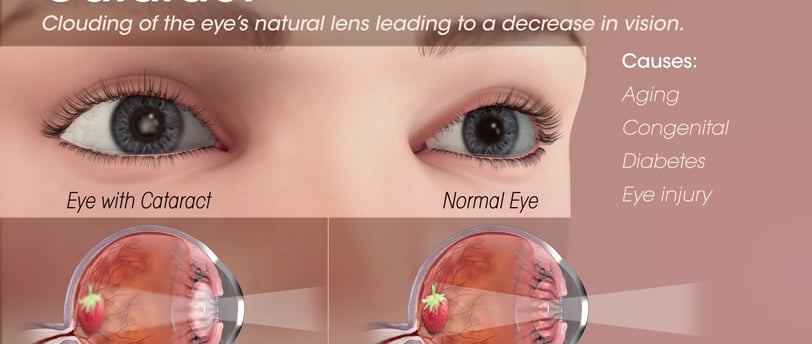Understanding Cataracts: Causes, Symptoms, and Treatment
2 min read


Cataracts are a common eye condition that affects millions of people worldwide, particularly those over the age of 40. In this blog post, we'll explore what cataracts are, their impact on vision, and the modern surgical techniques used to treat them.
What are Cataracts?
A cataract is the clouding of the eye's natural lens, which lies behind the iris and the pupil. This lens works much like a camera lens, focusing light onto the retina at the back of the eye. The lens also adjusts the eye's focus, letting us see things clearly both up close and far away.
The Impact of Cataracts
Cataracts are the most common cause of vision loss in people over age 40 and the principal cause of blindness in the world. In fact, there are more cases of cataracts worldwide than glaucoma, macular degeneration, and diabetic retinopathy combined.
Symptoms of Cataracts
As a cataract develops, you might experience:
Cloudy or blurry vision
Increased difficulty with vision at night
Sensitivity to light and glare
Seeing "halos" around lights
Frequent changes in eyeglass or contact lens prescription
Fading or yellowing of colors
Causes of Cataracts
While aging is the most common cause, other factors can contribute to the development of cataracts:
Diabetes
Smoking
Excessive alcohol consumption
Prolonged exposure to ultraviolet sunlight
Obesity
High blood pressure
Previous eye injury or inflammation
Prolonged use of corticosteroid medications
Cataract Surgery: A Modern Solution
Cataract surgery is one of the most common and successful surgical procedures performed today. Here's what you need to know:
Procedure: The cloudy lens is removed from the eye's capsule.
Lens Replacement: In most cases, the natural lens is replaced with an artificial intraocular lens (IOL).
IOL Types: There are various types of IOLs available, including monofocal, multifocal, and toric lenses for astigmatism correction.
Surgical Technique: Modern cataract surgery often uses a technique called phacoemulsification, which uses ultrasound waves to break up the lens for removal.
Recovery: Most patients can resume normal activities within a few days, with complete healing occurring within 8 weeks.
Success Rate: Cataract surgery has a high success rate, with about 98% of surgeries improving vision significantly.
When Surgery Isn't an Option
In rare cases where an IOL cannot be used, the patient may need to wear special cataract glasses or contact lenses to compensate for the removed natural lens.
Conclusion
Cataracts, while common, don't have to mean permanent vision loss. With modern surgical techniques, most people can regain clear vision and return to their normal activities. If you're experiencing symptoms of cataracts, it's important to consult with an eye care professional for a comprehensive eye examination and to discuss your treatment options.
Remember, early detection and treatment of cataracts can help preserve your vision and quality of life. Regular eye check-ups are crucial, especially as you age, to catch and address any developing eye conditions.